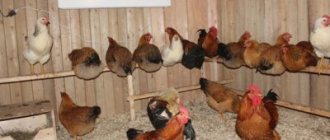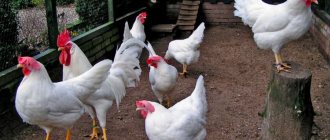Pros and cons of breeding chickens
Chicken farming is practically waste-free production. To get started, you do not need large financial investments, as well as knowledge and experience in this branch of animal husbandry. Breeding chickens is beneficial in that all the products and materials obtained can be easily sold or used for personal purposes. Thus, raising chickens can be your main source of income. Benefits of keeping poultry:
- Eggs - for breeding chickens and as an irreplaceable food product.
- Meat is a healthy product for people of any age.
- Feathers - used for sewing blankets, pillows, feather beds.
- Chicken manure - Often used by farmers as a fertilizer.
- Bones - used in various additives and as a fertilizer.
The disadvantages of growing chickens on poultry farms or in households are the need to build and equip a chicken coop, as well as the need for constant feeding.
Bird selection
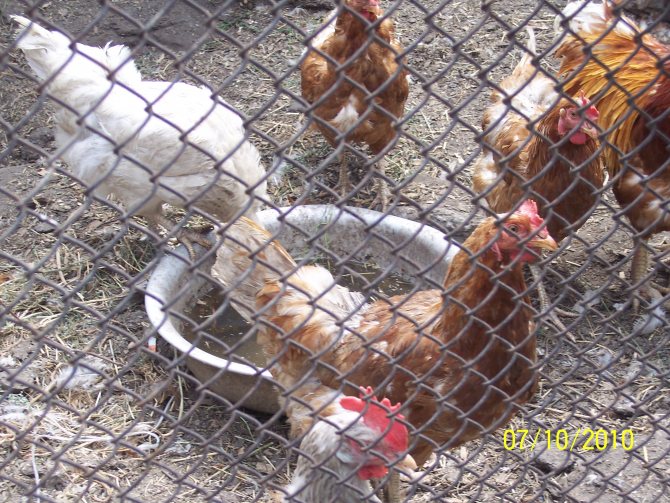
Before you start and raise chickens, you need clearly define with the needs and choose which breed of bird suits you best. Making the right choice is very important to a successful business.
First of all, you need to abandon the elite bird species. They are very whimsical and require special attention and care. Due to the beautiful and unusual plumage, such chickens are raised only for exhibitions and various competitions.
The best option for breeding is a breed of chickens that will grow quickly and lay well. Therefore, farmers most often choose meat breeds that practically do not get sick, eat relatively little, carry tasty eggs and have a good meat taste.
Among the large number of chicken breeds, it is worth choosing those that are most suitable for the local climate and meet your needs. Among these breeds, the following are distinguished:
- Adler silver. This species has a calm, peaceful nature and it is quite easy to care for them. Chickens have not very developed, but beautiful plumage. Juveniles begin to lay eggs at 6 months of age and lay approximately 180 eggs per year.
- Rhode Island. Birds of this breed are distinguished by their delicious meat. They are picky about food and can live not only in chicken coops, but also in cages. Chickens of this breed rush about once every two days.
- Kuchin jubilee. They are one of the best brood hens. Eggs begin to lay from the fifth month of life and bring about 220 eggs per year. The kurier plumage has a dark red color, the roosters are distinguished by their black tail and unusually curved beak.
- Moscow black. These chickens have beautiful black plumage with golden splashes on the neck. They rush about every other day. Their eggs are large and tasty.
- Yerevan. This mini breed is ideal for laying large numbers of eggs (laid almost every day). The hens have a bright brown color.
- Lohman Brown. One of the most lucrative chicken species. They lay very often and produce at least 320 eggs per year. However, after 80 weeks, they lose their high productivity and it becomes unprofitable to breed them.
- Russian white. This chicken is ideal for living in cold regions. It is frost-resistant, suitable for breeding, gains weight quickly and is absolutely not aggressive.
- New Hampshire. A very beautiful look of chickens with bright red-brown plumage.Individuals of this species are very friendly and tolerate low temperatures well.
- Barnevelder. These birds rarely lay, but in large eggs. Despite their Dutch origin, they perfectly adapt to the climate in which they live.
- Faverolle. Broilers of this breed are most often turned on because of their tender meat and attractive appearance.
Building a chicken coop
To care for chickens in winter, you need to build and equip chicken coop. For these purposes, you should not use utility rooms and sheds, since they are absolutely not intended for living chickens. For maximum comfort, the bird needs cleanliness, warmth and a sense of security. Only in this case will she become healthy and will lay many eggs. Despite the fact that building a chicken coop is an expensive undertaking, it is necessary to build it. You and your pets will immediately feel all the benefits, and the costs will pay off several times.
You can start building a chicken coop according to drawings from the Internet. They, as a rule, have been repeatedly tested on the experience of their predecessors and take into account all the necessary nuances. The starting material can be bricks, wood, blocks, chipboard, fiberboard and others. When choosing the area of \ u200b \ u200bthe chicken coop, you should follow a strict rule: no more than four birds can be placed on one square meter of the room.
Since chickens produce large amounts of ammonia, moisture and carbon dioxide, the building intended for the chicken coop must be well ventilated. At the same time, drafts should be avoided and the building should be located where there is no strong wind.
All nesting nests should be fairly large and can easily accommodate four chickens at a time. It is best to use sawdust or straw as bedding. Nests should be located in a dark corner of the coop and accessible for easy collection of eggs.
Growing chickens at home for beginners does not involve using cedar chips, which are toxic to poultry, as a floor base. It is best to use straw or wood chips, which should be changed at least once a week.
When building a chicken coop, it is necessary to protect it from the invasion of rats and mice. For this, a concrete foundation is installed or a cage mesh made of wire is dug in. For successful breeding of the bird, one should not forget about the larger predators, such as the fox or ferret. You can fight them by closing all entrances to the chicken coop at night.
Food for chickens
For successful home poultry farming, chickens must good and right eat. This will determine not only the speed of their growth, but also the taste of meat and eggs. On average, one chicken eats 100 g of feed per day. She supplements her meal with plants and insects, which she eats during her daily walk in the courtyard.
One of the favorite foods of all chicken breeds is corn. You can buy it or grow it yourself. The latter option is more time consuming, but profitable from a financial point of view.
The following foods should be excluded from the diet of chickens and adults:
- chocolate and other sweets;
- avocado;
- citrus;
- raw potatoes;
- wet food.
For normal digestion, birds need small pebbles. They swallow them, as the stones help grind hard corn or various grains. Their diet should also contain crushed eggshells, which will supply the chicken with calcium.
What breeds are suitable for beginners?
Beginners are advised to choose chickens from domestic breeds. This can be explained simply: they are more adapted to local climatic conditions than others. And the price for them is lower than for foreign birds. Next, it is determined what direction the chicken wants.
Beginners should pay attention to the following breeds:
- egg - Russian white;
- meat and egg - Russian crested, Russian black bearded (Galan), Leningrad golden-gray, Zagorsk salmon.
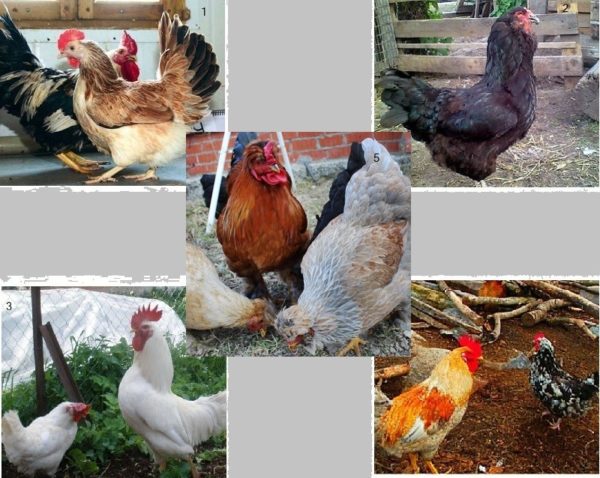

Breeds of chickens for home breeding: 1 - Zagorskaya salmon, 2 - Galan, 3 - Russian white, 4 - Leningrad golden-gray, 5 - Russian crested
Attention! Although Russian breeds are more accessible and hardy, in productivity they are inferior to their foreign counterparts.
Breeding chickens is a rather troublesome business, which requires a lot of time. Therefore, it is better to build a poultry house next to housing. If they plan to do this in the country, then you will have to move there.


Russian white breed of chickens
Care Tips
For the success of the business, the correct choice of laying hens and their home maintenance... On the video from the Internet, you can find many tips and recommendations for breeding them, but it is best to trust the experts in this matter and take into account the following nuances:
- It is necessary to keep the chicken coop clean. To do this, at least once a week, you need to clean the floor, feeders, overpasses.
- The reaction of the bird to this or that feed should be checked. In case of deterioration in health, it must be replaced or corrected.
- When chickens are cold, they gather in one place. If you notice this behavior, then you need to increase the temperature in the hen house by installing a heating system or simply by insulating its walls.
- In the summer, if the chicken is hot, then it begins to breathe heavily. To remedy the situation, you need to install additional drinking bowls with fresh and cool water.
- If a bleeding wound is detected in one of the birds, it is necessary to isolate it until the wound heals. If this is not done, other birds may peck at the cut and make the situation worse.
- Remember to do banding and daily counts of chicks and pullets, as they are small and can easily get lost in the grass or foliage.
Raising chickens
- It is necessary to take a box, line the bottom with newspapers, put a drinker and a feeder.
- An electric lamp should be placed on top (adjust the height of the incidence of the light so that it is 30 degrees on the floor). On the first day, the lighting should be around the clock, then the daylight hours are gradually reduced to 10 hours.
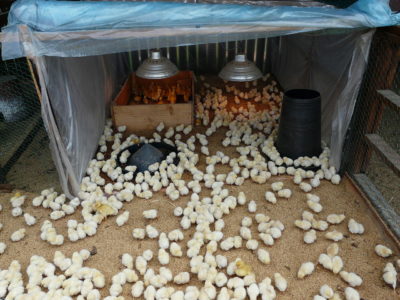

The newspaper should be changed 2 times a day.
If the chickens are huddled together, they are cold. If you try to stay away from the light, it's hot.- From day 5, the temperature needs to be reduced (end point - 19 degrees).
- From the box, the young are transferred to the bedding, then they are kept separately from the adult chickens for several months.
Prevention of poultry diseases
When breeding chickens, it is important to identify sick individuals in time and separate them from the rest. A chicken is sick if it has the following symptoms:
- shortness of breath and shortness of breath;
- cough;
- open wounds;
- loss of feathers;
- decrease in the number of eggs laid;
- refusal of water and food;
- enlargement of the abdomen;
- growth retardation.
This is not the case with chickens. Their health needs to be monitored several times a day. This will help avoid serious consequences and the loss of all individuals.
Use insect traps and never allow flies, which carry many infections, to appear.
While monitoring the health of your charges, do not forget about your own. Be sure to wear a respirator and gloves when cleaning the chicken coop of droppings. This is a compulsory measure, since chickens and chickens can carry serious diseases.
Breeding chickens at home is not only profitable, but also interesting. You will not need a lot of effort, time and money, and the result will please not only you, but all members of your family.
Buying young animals
Chickens can be purchased from specialized chicken farms. Or at large poultry farms. It is better to refuse offers from markets and Internet communities.There is a high probability of running into weak or sick individuals.
Pedigree pullets are bought in private nurseries, where they provide certificates and veterinary certificates.
It is difficult to determine the health status of day-old chicks. Therefore, menstruation is more often chosen. In a healthy chicken:
- active behavior;
- Round eyes;
- pink comb;
- straight legs;
- the head and neck are slightly arched;
- beak of the correct shape;
- the keel is elastic;
- the back is straight;
- clean fluff;
- even gait.
If the conditions for new poultry guests have been created, it's time to buy chickens. Babies can be purchased at collective farm markets and poultry farms, on the site of free advertisements and on farms whose employees are engaged in breeding work.
Websites and public markets are the most unsafe places to acquire young stock. No guarantees for live merchandise are provided here. Nobody knows what the buyer can expect inside the box with fluffy lumps. Perhaps, instead of the promised hens, village outbred hens are sitting there.
Chicks from large industrial poultry farms generally meet all the needs of buyers. But since the sale of young animals is not a priority in the activity of poultry farms, individuals that have not passed the standards of the enterprise enter the retail trade. So instead of healthy offspring, you can buy defective birds.
It is better to purchase chicks from enterprises that specialize in the selection of chickens. Before contacting such sellers, it is worth asking about their reputation over the past two to three years.
So, day old chicks are purchased, what next? You need to transport the chicks in a large, warm box. The bottom is covered with paper. On the way, do not shake the purchase, go at the minimum speed. For the first 5 days, you will have to feed the babies every couple of hours. In addition, in the process of breeding chickens, you need to closely monitor the temperature regime.
A table lamp is installed above the box. For the first five days, chicks should live at a temperature of 29-30 degrees. By the behavior of babies, one can understand whether they are comfortable in this state. If they huddle together and crush each other, the lamp should be lowered to raise the temperature and warm the chicks. If, on the contrary, they scatter away from the center, the distance to the lamp should be increased.
After five days of life, the chickens feel good at a temperature of 26 degrees. Every 6-7 days, the air in the box can be cooled by three degrees. Monthly individuals can easily tolerate an air indicator of 18 degrees. It is useful for birds to turn on an infrared lamp at night. If the weather permits, chicks can be taken out into the open area from the age of three days.
Important!
The chick box should not be made of foam or loose cardboard. Only purchased chickens will surely peck at the walls. If they manage to "feast on" inedible material, they may not get to their new home.
It is recommended to acquire young chickens at poultry farms. It is there that the rules of maintenance are strictly followed, there is a clear control of nutrition and prevention of diseases is carried out. When choosing young animals, you should pay attention to the following features:
- sufficient activity;
- healthy appearance;
- soft belly;
- clean cesspool;
- smooth beak and neck;
- normal head size;
- overgrown umbilical cord;
- adherence of the wings to the body.
In 1 month, it will be possible to determine the sex of the birds. It should be borne in mind that there should be at least 1 rooster for 10-13 females. If you plan to buy 20 females, you will need 2 males. This number of hens will produce approximately 60 eggs per week.

